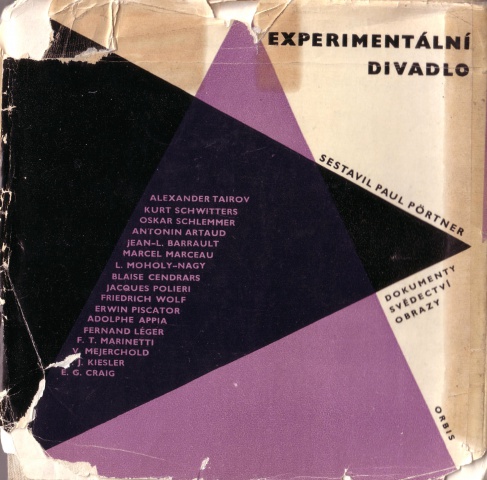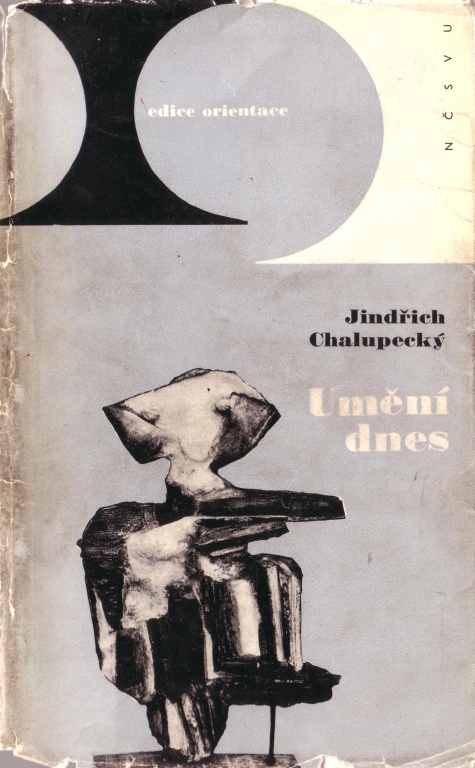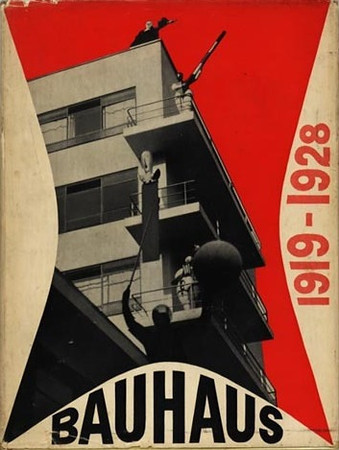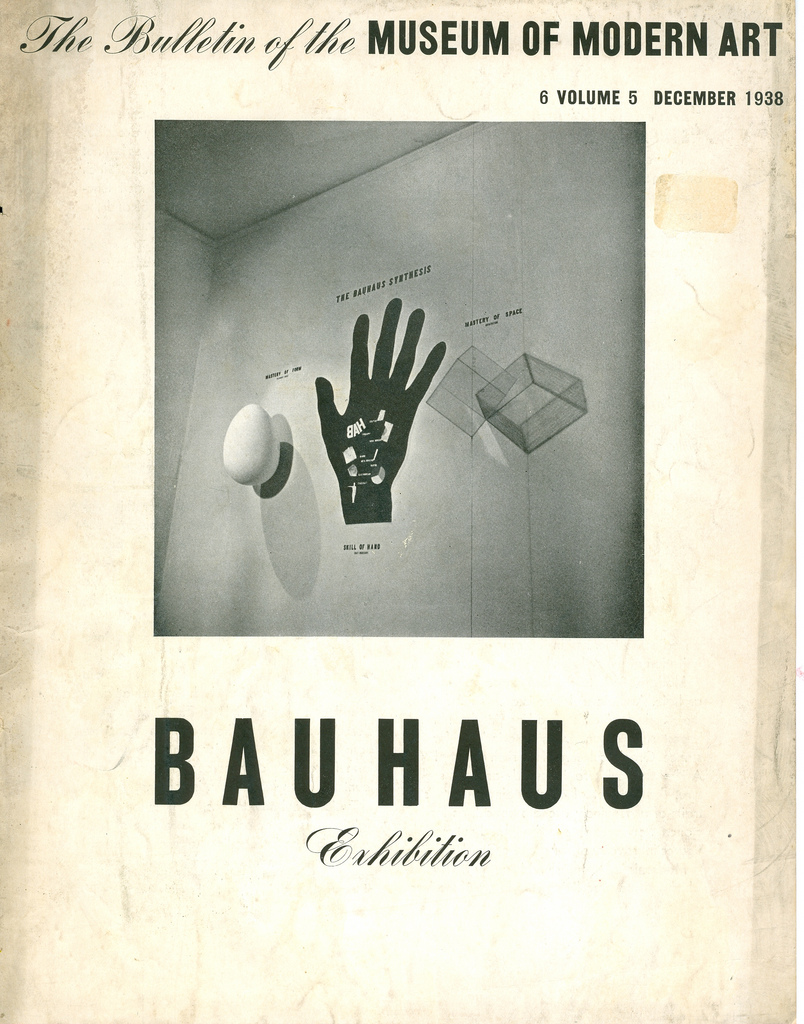Paul Pörtner (ed.): Experimentální divadlo: přehled, dokumenty, kresby, fotografie (1960/1965) [Czech]
Filed under book | Tags: · art history, avant-garde, experimental art, futurism, history of theatre, theatre

A history and documents of the experimental theatre edited in 1960 by the German playwright, novelist and translator.
“Pörtnerova kniha chce ve stručnosti, mnohdy až lapidární zkratkou, seznámit s výsledky nejdůležitějších pokusů, ktoré vznikly z vědomí neomezených možností moderního scénického prostoru a chtějí zbavit divadlo otrocké závislosti na konvenci a stagnaci, vlastní stávajícímu divadlu.
Výsledky pokusů velikých experimentátorů, mezi nimiž nechybí taková jména jako Appia, Craig, Marceau, Piscator, ale i Léger, Moholy-Nagy, Picasso, svítí nadále jako maják do budoucnosti, neboť jen málo impulsů z jejich bohatého odkazu přešlo do praxe současného divadla.
Ačkoli nelze očekávat, že idea ‘totálního divadla’ ožije v celé plnosti jejich představ, zůstává nicméně naděje, že sebevědomí divadla jako svébytného uměleckého druhu zesílí, že experimenty se specificky divadelními prostředky budou vedeny dále, aby se tak z dílčích událostí stala skutečná divadelní událost, ve které spojí experiment formy s novým obsahem.
Kniha může být cenným podnětem v našem soudobém uměnovedném myšlení a má význam i pro historii předválečného divadla, která má právě v této oblasti mnoho neujasněností a bílých míst.” (from the inside flap)
First published as Experiment Theater. Chronik und Dokumente, Arche, Zürich, 1960
Translated by Jan Rak
Publisher Orbis, Prague, 1965
Volume 4 of Monoskop Unlimited Edition series
176 pages
PDF (66 MB, no OCR)
Comment (0)Jindřich Chalupecký: Umění dnes (1966) [Czech]
Filed under book | Tags: · abstract art, art, art criticism, art history, art theory, avant-garde, happening, kinetic art, op art, pop art, theatre

A collection of essays on modern art by the eminent Czech art critic and art historian.
“Podoba výtvarného umění se od konce 2. světové války prudce měnila. Ve čtyřicátých letech nastoupily nové nefigurativní směry, označované jako lyrická abstrakce, akční malba, materiálové umění, a nabyly v desetiletí 1950-1960 takového významu, že se abstrakce zdála jedinou možností moderního umění. Ale od začátku šedesátých let se uplatňuje řada tendencí docela jiných a mnohdy překvapivých: pop art, nová figurace, kinetismus, vizualismus…
Tento vývoj byl u nás sledován neúplně a zkresleně. Autor se proto snaží v řadě esejů, které jsou jádrem knihy, vylíčit dramatickou situaci, do níž dospělo moderní umění, a kriticky ukázat původ a smysl tohoto složitého dění. Těmto esejům předesílá informativní přehled vývoje avantgardního umění od abstraktního expresionismu, dada a surrealismu až k nejposlednějším experimentům, jako jsou happenings, v nichž se stupňuje působení uměleckého díla až do divadelních forem, a events, dematerializujících naopak umělecké dílo až v pouhý pomysl. V syntetickém závěru konečně ukazuje sociální a historický smysl současného umění. 64 ilustrací text dokumentuje.” (from the cover)
Publisher Nakladatelství československých výtvarných umělců, Prague, 1966
Volume 3 of Monoskop Unlimited Edition Series
263 pages
PDF (89 MB, no OCR)
For more from Chalupecký see Monoskop wiki.
Herbert Bayer, Walter Gropius, Ise Gropius (eds.): Bauhaus 1919–1928 (1938)
Filed under book, catalogue | Tags: · 1920s, architecture, art, art history, avant-garde, bauhaus, design, graphic design, industrial design, painting, photography, sculpture, typography


Bauhaus 1919-1928 remains one of the most valuable accounts of the Bauhaus school. The book was published in conjunction with the Museum Of Modern Art exhibition (December 7, 1938-January 30, 1939) and is a point-for-point record of actual programs and projects at the Bauhaus, prepared by Herbert Bayer under the general editorship of Walter Gropius and Ise Gropius and with the collaboration of a dozen other Bauhaus teachers — including Kandinsky, Klee, Feininger, Schlemmer, Itten, Moholy-Nagy, Albers, and Breuer. Rather than a retrospective history, it is a collection of photographs, articles, and notes prepared on the field of action. It may be considered as much a work of the Bauhaus as it is a work about it.
Includes work by all the Bauhaus faculty including Walter Gropius, Paul Klee, Wassily Kandinsky, Laszlo Moholy-Nagy, Marcel Breuer, Herbert Bayer, Josef Albers, Lyonel Feininger, Oskar Schlemmer, Hannes Meyer, Mies van der Rohe, Anni Albers, Otti Berger, Gunta Stolzl, Max Bill and many others.
The exhibition gave the first comprehensive review of the development of the institute under Gropius (no material from the later Bauhaus was shown). Preparation and technical arrangements were entrusted to Herbert Bayer, paving the way for his own emigration to America shortly afterwards. An accompanying Bulletin was a privilege, sent to members of MOMA. (Source)
Bauhaus 1919-1928
With a Preface by Alfred H. Barr, Jr.
Publisher Museum of Modern Art, New York, 1938
224 pages
via Joaquim Moreno, update via MoMA
The Bulletin of the Museum of Modern Art 6, Vol. 5 (Dec 1938): Bauhaus Exhibition
Publisher Museum of Modern Art, New York, 1938
8 pages
via David Levine
PDF (Book, 42 MB, updated on 2016-9-17)
PDF (Bulletin)

